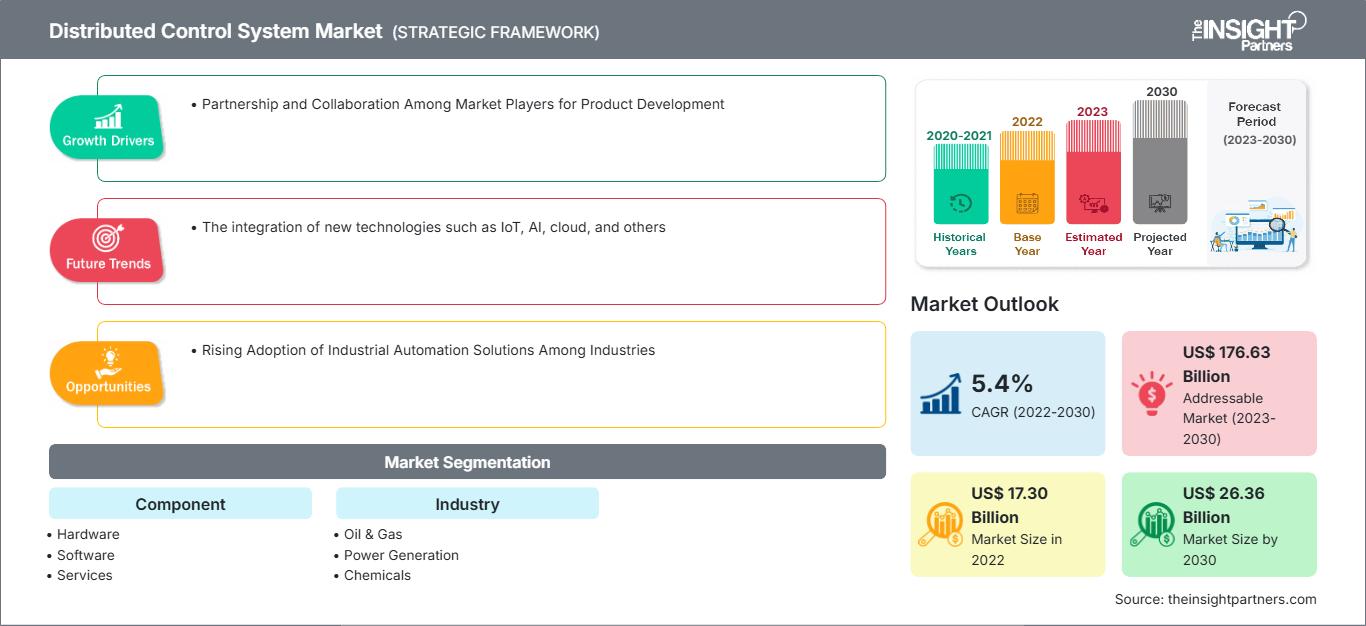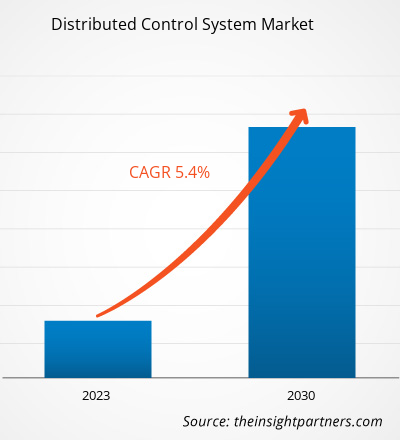分布式控制系统市场规模预计将从 2022 年的 173 亿美元增至 2030 年的 263.6 亿美元。预计该市场在 2022 年至 2030 年期间的复合年增长率为 5.4%。物联网、人工智能、云等新技术的融合可能仍将是市场的主要趋势。
分布式控制系统市场分析
各行各业越来越多地采用工业自动化解决方案,以及电力和能源行业的不断发展,正在推动市场的发展。由于新制造设施的建设,预计市场在预测期内将会增长。此外,市场参与者在 DCS 产品开发和架构开发方面的伙伴关系和协作正在为市场创造丰厚的商机。
分布式控制系统市场概览
分布式控制系统 (DCS) 是一个计算机化系统,由分布在整个工厂的传感器、控制器和相关计算机组成。每个部件都具有特定的功能,例如数据采集、过程控制、数据存储和图形显示。这些不同的部件通过工厂的局域网 (LAN)(也称为控制网络)与中央计算机通信。
分布式控制系统 (DCS) 可实现连续和批量生产过程中工业设备的自动化,同时降低人为和环境风险。该系统广泛应用于各行各业,包括采矿、化工生产、运输和加工、电力生产、水和废水处理以及制药加工厂。
自定义此报告以满足您的要求
您将免费获得任何报告的定制,包括本报告的部分内容,或国家级分析、Excel 数据包,以及为初创企业和大学提供超值优惠和折扣
分布式控制系统市场: 战略洞察

-
获取本报告的主要市场趋势。这个免费样本将包括数据分析,从市场趋势到估计和预测。
分布式控制系统市场驱动因素和机遇
各行业对工业自动化解决方案的采用日益增多,利好市场
工业自动化被广泛定义为在工业或制造环境中使用硬件和组件来实现系统自动化。各大公司正在推出各种计划,以鼓励采用工业自动化。例如,2023年9月,罗克韦尔自动化与BIC合作,利用Plex制造执行系统(MES)推动数字化转型和效率提升。企业的此类举措将推动分布式控制系统市场的增长。此外,石油天然气、石化和制药行业正在迅速扩张。由于技术先进的公司的存在,加上政府在研发方面的支出增加,这些垂直行业的技术进步也很快。
市场参与者在产品开发方面的伙伴关系与协作
全球许多行业都实现了大幅扩张。全球范围内,专注于ICT领域的自动化公司数量日益增多。例如,2023年10月,总部位于魁北克、开发出全球唯一全集成制造自动化平台(MAP)的Vention公司宣布获得FTQ基金会1500万美元的投资。Vention在合作伙伴的助力下持续保持强劲增长,致力于实现工业自动化的大众化,提升制造企业的生产力和竞争力。此外,企业的探索和改进也促进了先进技术的运用。例如,2023年8月,ANYbotics选择MicroWatt Controls作为经销商合作伙伴,扩大了其在加拿大的业务范围。总部位于卡尔加里的MicroWatt Controls已将其检测机器人的部署范围扩展到加拿大的石油天然气、化工、能源和采矿行业。预计过程工业的持续发展将推动加拿大市场对分布式控制系统的需求。
分布式控制系统市场报告细分分析
有助于得出分布式控制系统市场分析的关键细分市场是组件和行业。
- 基于组件,分布式控制系统市场分为硬件、软件和服务。软件部门在 2022 年占据了更大的市场份额。
- 基于行业,市场分为石油和天然气、发电、化学品、食品和饮料、制药等。石油和天然气部门在 2022 年占据了更大的市场份额。
按地区划分的分布式控制系统市场份额分析
分布式控制系统市场报告的地理范围主要分为五个区域:北美、亚太地区、欧洲、中东和非洲以及南非。中美洲。
由于汽车行业的扩张,预计欧洲市场在预测期内将扩大。意大利政府大力支持汽车行业。例如,据工会称,2023年12月,意大利政府已拨款约65亿美元用于支持其汽车行业。此外,2023年7月,菲亚特母公司Stellantis与意大利政府达成协议,计划将意大利的汽车年产量提高到100万辆,扭转近年来的下降趋势。这些行业的增长对工业控制系统产生了积极影响。因此,汽车行业对DCS的需求正在增长。
分布式控制系统市场
The Insight Partners 的分析师已详尽阐述了预测期内影响分布式控制系统市场的区域趋势和因素。本节还讨论了北美、欧洲、亚太地区、中东和非洲以及南美和中美洲的分布式控制系统市场细分和地域分布。
分布式控制系统市场报告范围
| 报告属性 | 细节 |
|---|---|
| 市场规模 2022 | US$ 17.30 Billion |
| 市场规模 2030 | US$ 26.36 Billion |
| 全球复合年增长率 (2022 - 2030) | 5.4% |
| 历史数据 | 2020-2021 |
| 预测期 | 2023-2030 |
| 涵盖的领域 |
By 组件
|
| 覆盖地区和国家 |
北美
|
| 市场领导者和主要公司简介 |
|
分布式控制系统市场参与者密度:了解其对业务动态的影响
分布式控制系统市场正在快速增长,这得益于终端用户需求的不断增长,而这些需求的驱动因素包括消费者偏好的演变、技术进步以及对产品优势的认知度的提升。随着需求的增长,企业正在扩展其产品线,不断创新以满足消费者需求,并利用新兴趋势,从而进一步推动市场增长。

- 获取 分布式控制系统市场 主要参与者概述
分布式控制系统市场新闻及最新发展
分布式控制系统市场评估通过收集一手和二手研究的定性和定量数据进行,这些数据包括重要的公司出版物、协会数据和数据库。分布式控制系统市场的一些发展如下:
- ABB 发布了最新版本的 ABB Ability Symphony Plus 分布式控制系统 DCS,以协助发电和水务行业的数字化转型。最新版本的 Symphony Plus 将通过提供简化且安全的 OPC UA1 连接到边缘和云端,而不会干扰关键的控制和自动化功能,从而增强客户的数字化之旅。(来源:ABB 有限公司,公司网站,2023 年 2 月)
分布式控制系统市场报告内容及交付成果
“分布式控制系统市场规模及预测(2020-2030 年)”报告对市场进行了详细的分析,涵盖以下领域:
- 分布式控制系统市场规模以及涵盖范围内所有关键细分市场的全球、区域和国家/地区预测
- 分布式控制系统市场趋势以及市场动态,例如驱动因素、限制因素和关键机遇
- 详细的 PEST/波特五力模型和 SWOT 分析
- 分布式控制系统市场分析,涵盖关键市场趋势、全球和区域框架、主要参与者、法规和最新市场发展
- 行业格局和竞争分析,涵盖市场集中度、热图分析、知名参与者和分布式控制系统市场的最新发展
- 详细的公司简介
- 历史分析(2 年)、基准年、预测(7 年)及复合年增长率
- PEST和SWOT分析
- 市场规模、价值/数量 - 全球、区域、国家
- 行业和竞争格局
- Excel 数据集
近期报告
客户评价
购买理由
- 明智的决策
- 了解市场动态
- 竞争分析
- 客户洞察
- 市场预测
- 风险规避
- 战略规划
- 投资论证
- 识别新兴市场
- 优化营销策略
- 提升运营效率
- 顺应监管趋势






















 获取免费样品 - 分布式控制系统市场
获取免费样品 - 分布式控制系统市场